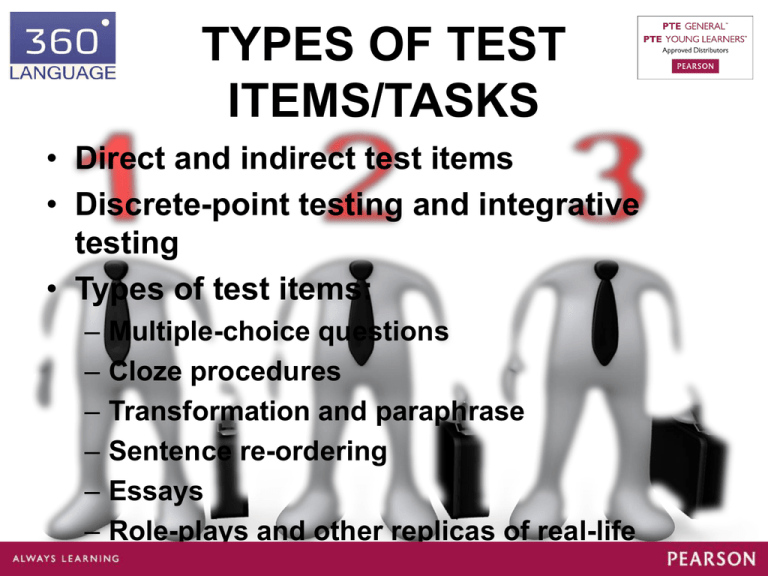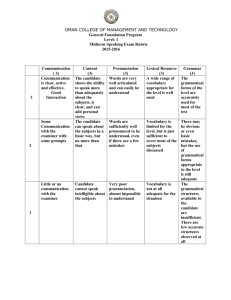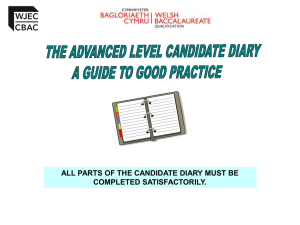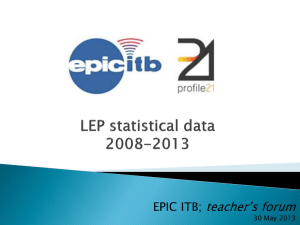TYPES OF TEST ITEMS/TASKS
advertisement

TYPES OF TEST ITEMS/TASKS • Direct and indirect test items • Discrete-point testing and integrative testing • Types of test items: – – – – – – Multiple-choice questions Cloze procedures Transformation and paraphrase Sentence re-ordering Essays Role-plays and other replicas of real-life interaction TASKS to assess SPEAKING SKILLS • • • • • Interviews Information-gap activities Decision-making activities Using pictures Role-play activities TASKS to assess WRITING SKILLS • • • • • • • Compositions Stories Transactional letters Information leaflets Essays Newspaper articles A set of instructions for other common tasks TASKS to assess READING SKILLS • Multiple-choice questions • Matching activities • Transferring written information to charts, graphs, maps, etc. • Summaries • Headings • Inserting paragraphs TASKS to assess LISTENING SKILLS • • • • • Completing charts with facts and figures Identifying objects Identifying speakers Identifying attitudes and opinions Following directions (e.g. on the map) MARKING A TEST • • • • • Training More than one scorer Global assessment scales Analytical profiles Scoring and interacting during oral tests GLOBAL ASSESSMENT SCALES (Oral Ability) Scor Description e 0 The candidate is almost unintelligible, uses words wrongly and shows no sign of any grammatical understanding 1 The candidate is able to transmit only very basic ideas, using individual words rather than phrases or fuller patterns of discourse. Speech is very hesitant and the pronunciation makes intelligibility difficult 2 The candidate transmits basic ideas in a fairly silted way. Pronunciation is sometimes problematic and there are examples of grammatical and lexical misuse and gaps which impede communication on occasion. 3 The candidate transmits ideas moderately clearly. Speech is somewhat hesitant and there are frequent lapses in grammar and vocabulary use. Nevertheless, the candidate makes him/herself understood. 4 The candidate speaks fairly fluently, showing the ability to communicate ideas with not too much trouble. There are some problems of grammatical accuracy and some words are inappropriately used. 5 The candidate speaks fluently with few obvious mistakes and a wide variety of lexis and expression. Pronunciation is almost always intelligible, and there ANALYTICAL PROFILES Criteria Pronunciation Fluency Use of vocabulary Use of grammar Intelligibility Repair skills Task completion Score (see analytical scales) ANALYTICAL SCALES (Fluency) Scor e Description 0 The candidate cannot get words or phrases out at all. 1 The candidate speaks hesitantly in short, interrupted bursts. 2 The candidate speaks slowly with frequent pauses. 3 The candidate speaks at a comfortable speed with quite a lot of pauses and hesitations. 4 The candidate speaks at a comfortable speed with only an occasional pause or upset. 5 The candidate speaks quickly with few hesitations. PUBLIC (INTERNATIONAL) EXAMS • GENERAL ENGLISH exams – Cambridge ESOL – Pearson PTE – City and Guilds Pitman • ACADEMIC ENGLISH exams – IELTS – PTE Academic – TOEFL and TOEIC • BUSINESS ENGLISH exams – LCCI (London Chamber of Commerce and Industry) – Cambridge ESOL – City and Guilds Pitman TEACHING FOR TESTS • Backwash, or washback, effect Teaching becomes dominated by the test • A range of activities VS exam-format tasks • A clear sense of purpose VS a less clear focus • Teacher-driven learning VS autonomous learning “It’s important to build variety and fun into an exam course as it is to drive Ss towards the goal of passing their exam” Burgess and Head 2005 • “Hitting the target” STRATEGIES Train for test types Getting ‘inside the heads’ of the test designers • Discuss general exam skills Building Ss up to an exam • Do practice tests Getting a feel for the experience • Have fun Eliminating boredom and tension • Ignore the test Working on general language issues, taking part in motivating activities from time to time TIPS FOR TEACHERS 1. Try to view assessment as a CELEBRATION OF LEARNING Discover where mistakes are made and ways to fix them is as much a celebration as it is an acknowledgment of strengths for use in further growth 2. Give Ss CHOICE IN THEIR ASSESSMENT TASKS where appropriate When Ss are given choice, they engage more deeply in the assessment activity, and their results are more likely to provide valid inferences 3. Give Ss the OPPORTUNITY TO MAKE MISTAKES in their assessment Mistakes provide feedback they can use to adjust what they are doing THANK YOU







